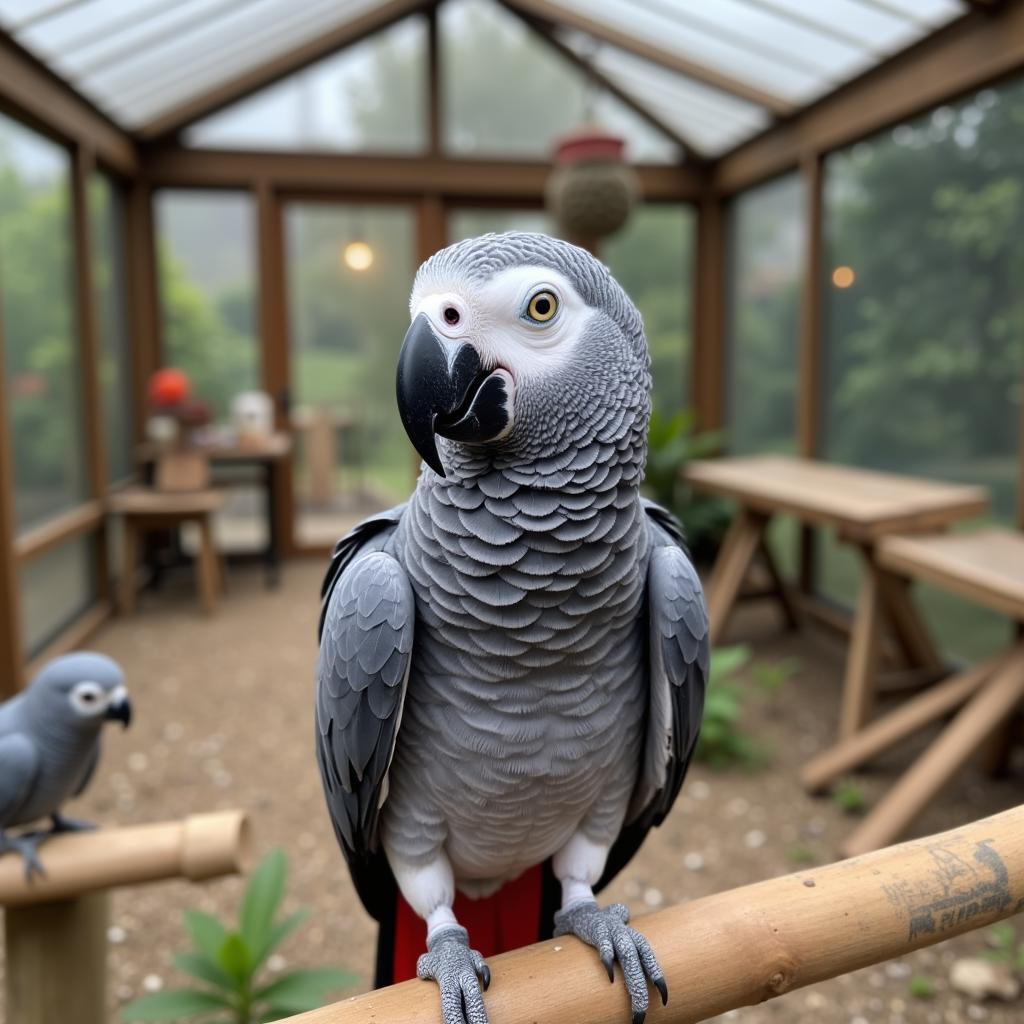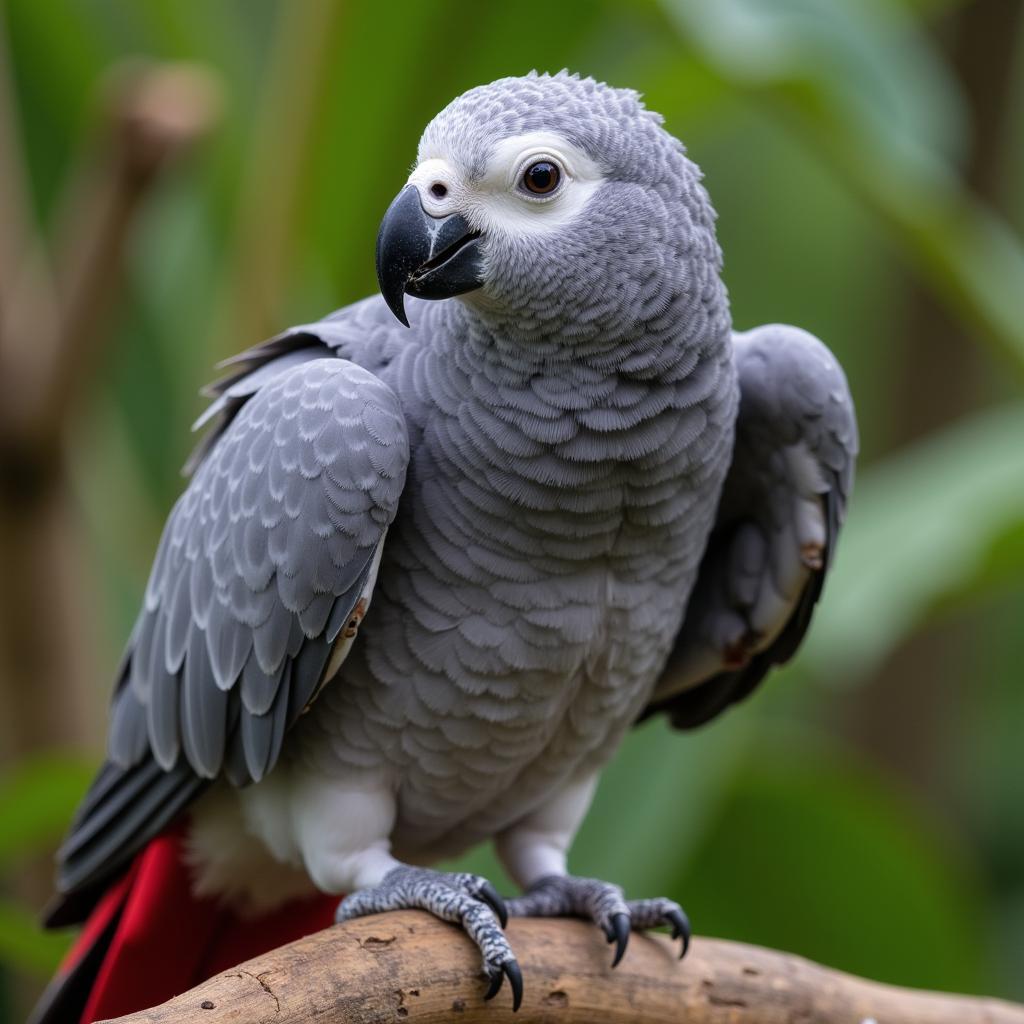Discovering the Diverse African Grey Varieties
The African Grey parrot, admired for its intelligence and talking ability, isn’t a one-size-fits-all species. There are actually distinct African Grey Varieties, each with its own unique characteristics and charm. Whether you’re considering welcoming one of these remarkable birds into your home or simply curious about their captivating diversity, join us as we delve into the fascinating world of African Grey varieties.
Congo African Grey vs. Timneh African Grey: Unraveling the Differences
When we talk about African Grey varieties, we’re primarily referring to two main types: the Congo African Grey and the Timneh African Grey. While they share the same genus and many similar traits, noticeable distinctions set them apart.
Size and Appearance: A Tale of Two Greys
The Congo African Grey, as its name suggests, is native to the Congo Basin in Africa. It’s the larger of the two varieties, typically measuring between 12-14 inches in length. These majestic birds boast a stunning plumage of predominantly silver-grey feathers, accented by a bright red tail. Their beaks, a tool for both communication and enjoying treats, are black and strikingly prominent.
In contrast, the Timneh African Grey, hailing from the rainforests of Upper Guinea, is slightly smaller, averaging around 10-12 inches in length. Their plumage showcases a darker shade of charcoal grey, with their tail feathers displaying a distinctive maroon hue. Unlike the Congo African Grey’s black beak, the Timneh possesses a unique horn-colored upper mandible.
Beyond the Physical: Temperament and Talking Prowess
While both varieties are renowned for their intelligence and ability to mimic human speech, subtle differences in temperament and vocalizations have been observed. Congo African Greys are often described as more sensitive and prone to anxiety compared to their Timneh counterparts. Timnehs, on the other hand, are generally considered more laid-back and adaptable, making them a popular choice for first-time bird owners.
When it comes to talking ability, both varieties excel. However, Congo African Greys are anecdotally known for possessing a slightly larger vocabulary and a remarkable ability to mimic human speech with impressive clarity. Timnehs, while equally capable of learning a wide range of words and phrases, often have a raspier and more high-pitched voice compared to the Congo’s deeper, clearer tones.
“In my experience, both Congo and Timneh African Greys make wonderful companions,” shares avian veterinarian Dr. Anya Patel. “While individual personalities can vary, understanding the subtle differences between these varieties can help potential owners make informed decisions about which type best suits their lifestyle and expectations.”
Choosing the Right African Grey for You
Deciding to bring any parrot into your life is a big decision, and choosing between African Grey parrot varieties adds another layer of consideration. Reflecting on your lifestyle, experience with birds, and expectations for companionship are essential steps in the decision-making process.
If you’re seeking a highly intelligent and talkative companion and are prepared to provide ample mental stimulation and socialization to mitigate potential anxiety, the Congo African Grey might be a good fit. If you prefer a slightly smaller, more adaptable companion, and perhaps a first-time bird owner, the Timneh African Grey could be the perfect match.
A Lifelong Commitment: Caring for Your African Grey
No matter which African Grey variety captures your heart, remember that bringing one home is a long-term commitment. These intelligent and social creatures thrive on interaction, enrichment, and a nurturing environment. Providing a spacious cage, a varied African Grey parrot food diet rich in fresh fruits and vegetables, and plenty of mental stimulation through toys and interaction are crucial aspects of responsible African Grey ownership.
Understanding the nuances of African grey parrot diet is also important. These birds are prone to calcium deficiencies, so providing them with a balanced diet and consulting with an avian veterinarian is crucial for their well-being.
Embracing the African Grey’s Unique Personality
Beyond their stunning appearance and talking abilities, African Greys possess a depth of African Grey personality that continues to captivate bird enthusiasts worldwide. They are known for their intelligence, sensitivity, and ability to form strong bonds with their human companions. Providing them with a loving and stimulating environment will not only ensure their physical health but also nurture their incredible emotional and intellectual capacity.
“The bond between an African Grey and their human companion is truly special,” observes avian behaviorist Dr. Sarah Williams. “These birds are incredibly perceptive and thrive on interaction. They’re not just pets; they’re members of the family who enrich our lives with their intelligence, humor, and unwavering companionship.”
African Grey Varieties: A Testament to Nature’s Diversity
The world of African Grey parrots extends beyond a single species, offering a captivating glimpse into the beauty of natural variation. Whether drawn to the grandeur of the Congo or the charm of the Timneh, these intelligent and affectionate creatures continue to fascinate and inspire. Remember, choosing the right African Grey variety for your lifestyle is just the first step in a rewarding journey of companionship with one of nature’s most remarkable creations.
Frequently Asked Questions
Q: Do African Grey parrots make good pets for families with children?
A: African Greys can make wonderful family pets, but their suitability for households with young children depends on various factors. These birds require a lot of attention and can be sensitive to loud noises and sudden movements. It’s essential to teach children how to interact with the bird respectfully and supervise their interactions closely.
Q: How long do African Grey parrots live?
A: With proper care, African Grey parrots can live for an impressive 40-60 years or even longer, making them a long-term commitment for any potential owner.
Q: Are African Grey parrots difficult to train?
A: African Greys are highly intelligent and eager to learn, which can make training a rewarding experience. However, they require patience, consistency, and positive reinforcement techniques.
Q: What are some common signs of illness in African Grey parrots?
A: Changes in appetite, feather plucking, lethargy, respiratory distress, and droppings abnormalities can all be signs of illness in African Grey parrots. If you notice any of these signs, it’s essential to consult with an avian veterinarian immediately.
Q: Where can I find a reputable breeder or adoption center for African Grey parrots?
A: Researching and finding a reputable breeder or adoption center is crucial when welcoming an African Grey into your home. Seek recommendations from avian veterinarians, experienced bird owners, or reputable bird clubs.
Need Help? Contact Us
For further information and personalized assistance, feel free to reach out to us:
- Phone: +255768904061
- Email: kaka.mag@gmail.com
- Visit us: Mbarali DC Mawindi, Kangaga, Tanzania.
Our dedicated team is available 24/7 to address your queries and provide expert guidance.


